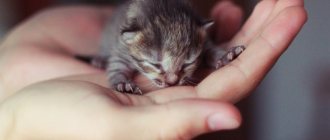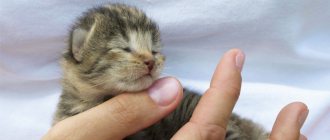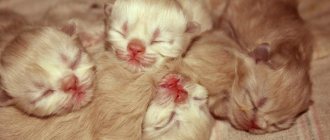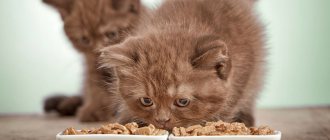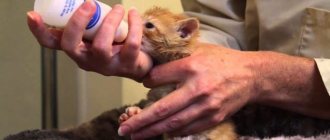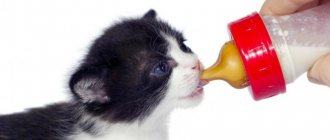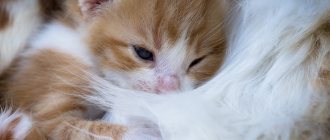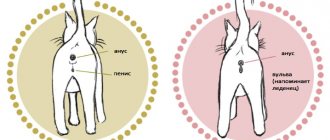After reading the material, you will find out whether it is possible to feed milk to kittens and adult cats, about the dangers and benefits of milk for the cat’s body. In the article, we talked about the types of milk in a kitten’s diet and how you can feed a kitten left without a mother. We also figured out how to identify lactose intolerance in animals.
The classic image of kittens lapping milk from a bowl is familiar to many from childhood. Therefore, many owners often give it to kittens first. However, it is important to understand that this is not necessary and milk for kittens can be a source of problems.
Small and adult cats love milk very much
Nutritional features of kittens
For the first two months of their lives, kittens get everything they need from cat's milk. At this age, they digest their mother’s milk well thanks to the enzyme lactase. This enzyme is necessary to break down the lactose contained in milk. With age, the production of lactase in the pet’s body decreases, but the animal’s appetite for milk may remain.
Month-old kittens gradually begin to switch to solid food, trying to eat meat products little by little with the cat. At the same time, they do not stop feeding on their mother’s milk. In the kitten’s body, preparation for adult life begins: the production of lactase is gradually reduced to a minimum, and other enzymes are produced for digestion, which are involved in the breakdown of protein foods.
The kitten's body absorbs mother cat's milk well
By 2 months of age, the cat begins to wean the kittens from breastfeeding, and they begin to feed on their own. At this time, lactase usually stops being produced.
For cubs, milk is the main food, but for adult cats it is contraindicated due to the fact that the gastrointestinal tract does not digest it, which can cause bloating, pain and diarrhea. There are rare cases where lactase continues to be produced in the body of an adult cat.
Adult cats produce almost no lactase
Feeding procedure
- Sit in a comfortable position, lay a bedding on your knees - a towel, a diaper;
- The kitten needs to be placed in the same position as when sucking milk from a cat - standing, lying on its stomach with an elevated position;
- Squeeze out a little product so that the kitten feels the smell, takes the pacifier in its mouth, if this does not happen, carefully insert it into the mouth, then instinct will react;
- You need to feed a newborn with a pipette; you should not squeeze out the contents. It is necessary for him to develop a sucking instinct; he does it himself;
- After about 7 days, you need to switch to a syringe, but squeeze out the milk slowly so as not to choke.
Milk for kittens - benefits and harm
Milk is undoubtedly a product rich in beneficial components. These are fatty acids, animal proteins and various microelements. They are sources of energy, and most of the components in its composition are building materials for new cells.
Milk has many benefits, but it can also have a negative impact on a kitten's health. Disadvantages of eating milk:
- indigestion;
- imbalance of proteins, fats and carbohydrates;
- the danger of sand and stones forming in the cat’s bladder;
- risk of developing an allergic reaction to milk.
Many veterinarians agree that milk is completely useless for adult cats, since its components are practically not absorbed by their bodies.
Milk contains many useful substances, but it can be dangerous for a kitten
What does a kitten need to grow?
Receiving nutrition from liver glycogen, newly born kittens can go without food for the first few hours, while underdevelopment of the sucking reflex and incomplete activation of digestive functions are observed. On average, the weight of newborn kittens ranges from eighty to one hundred and twenty grams.
The following dynamics are characteristic of normal growth: their weight doubles after the first week, then the weight gain is approximately one hundred grams. The average weight of a two-month-old kitten can reach 1-1.3 kilograms.
The umbilical cord usually dries out on the second day, and after three or four days it falls off. After seven to fourteen days, the kittens' eyes begin to water, and by the appearance of a dark edging around the closed eyelids, it can be assumed that the babies will soon open their eyes. As a rule, this happens within two to three days. First one eye opens, and then the second. If necessary, they are washed with a diluted chamomile decoction. Remember that the more time you spend with your kittens in the first weeks of their lives, the better they will feel later on.
Because for a grown kitten, you will remain the only and beloved “mother” until the end of your days.
Warmth and comfort
The temperature in the kitten house should be about 28-30 degrees C. A cardboard box measuring forty by fifty centimeters is suitable for this. Until the eyes open, about two weeks, the box must be closed and the kittens kept in the dark. At the same time, after opening your eyes, do not expose them to bright light. And when feeding, you should slightly close the curtains and turn on the light.
One heating pad should be placed on four sides of the box. Glass bottles with a capacity of 0.5-0.6 liters are suitable for this. Every five to six hours, boiling water is poured into them, while they are wrapped in a terry towel in 5-6 layers. You should not use a linen towel because it transfers heat and wool too much, as kittens can become entangled in the threads pulled out by the claws. With this heating, if the walls are hot, the kittens sleep in the center of the box.
And vice versa, if they have gathered in any of the corners, then you need to pour boiling water into the heating pads again. This should be combined with the next feeding, since there is no need to wake the kittens up again. So that they can move easily, you need to lay a smooth cloth on the bottom of the box.
Hygiene
During each feeding it is necessary to carefully examine the kittens. Take a hard cloth slightly moistened with warm water, linen is suitable for this, and gently wipe the kitten’s ears, head, back, sides and paws. This imitates the process of a cat washing itself.
Next you need to massage the tummy and force the kitten to urinate by massaging the surface on the inner thighs around the urethra. As a rule, there are no difficulties with this. If the rules for care and feeding are followed, once every two or three days, kittens walk around.
Lactose intolerance in kittens - signs
Lactose or milk sugar is found only in milk.
Symptoms of lactose intolerance become apparent approximately 8-12 hours after the kitten drinks the milk. Intolerance manifests itself in the form of diarrhea, vomiting and bloating.
This happens due to the inability of the kitten’s body to process lactose, which passes through the intestines unchanged. By attracting water, it moves further and in the large intestine it meets bacteria that try to process it. This is accompanied by the release of hydrogen, carbon dioxide and a number of other substances, causing fermentation in the kitten’s body.
Lactose is found only in milk
How often to feed a newborn kitten
The frequency of feeding kittens abandoned by a cat has long been determined by experts.
Until the fourth day of life, babies are fed every 2 hours around the clock. On the fifth day, the frequency changes: the baby can tolerate it for 3 hours. From the 14th day, only one night feeding is left, daytime feedings are left at the same interval. After 25 days of life, you need to feed 1 time at night; during the day, the interval between meals is 3-4 hours. From the 35th day, a gap of 4 hours is left during the day, and night feeding is removed.
If you have the fate of feeding a newborn kitten in the first days, then do not overfeed the cub: he is given 3-4 ml per feeding. With growth, the interval between meals and the single dose increase.
Is it possible to give cow's milk to a kitten?
Cow's milk contains many vitamins and nutrients. It contains elements such as iodine, calcium, magnesium, selenium and others. These components are important for a kitten, but we must not forget that the composition of such milk is very different from cat milk. It is not as nutritious and does not contain the amount of nutrients needed for normal development. But this milk also contains elements that are either simply not needed by the pet or can be harmful to health.
Cow's milk is a difficult product for kittens. It can cause an allergic reaction and diarrhea. If the cow was fed industrial feed that contained pesticides, then consuming milk from such a cow can cause poisoning. A pregnant cow produces milk with a high content of the hormone estrogen, which can lead to hormonal imbalance in the kitten, and subsequently to serious illnesses. Sterilized milk from the store is a useless product for an animal, from a nutritional point of view.
Cow's milk can cause allergies in kittens
You can try giving your pet lactose-free milk. It is harmless to the kitten. However, there is no practical benefit from this type of milk.
What should you not feed newborn kittens?
If you listen to the advice of experts, ignoring common sense, then it won’t take long for things to get into trouble. There are several “don’ts” in feeding newborn kittens, in addition to a strict feeding schedule, dosage and food intake rules.
- Cow's milk is not used in its pure form, as this can lead to severe indigestion and possible death.
- No cream, even diluted with water.
- Don’t rush and shove sausage or minced meat into your baby’s mouth.
- When the baby gets a little older, you also shouldn’t rush to feed him raw freshwater fish, otherwise he may be attacked by helminths.
Are sheep and goats allowed?
Goat's milk is easier to digest and is absorbed very quickly by the kitten's body. It should also be noted that it contains vitamins A, B1 and B2. The proteins contained in such milk are much less likely to cause intolerance in kittens. Goat's milk is better in composition than cow's milk. In addition, it is low-allergenic. Sheep milk is very similar in properties to goat milk.
Don't forget that store-bought cow's milk usually has reduced fat content, while goat's or sheep's milk is most often sold with natural fat content.
Thus, the question of whether it is possible to give a kitten goat’s milk can be answered positively, but it is advisable to dilute it with a small amount of water.
Goat's milk is much healthier for a kitten than cow's milk
Blend recipes
Preparing food for kittens is quite simple. The main ingredient is, of course, milk. Auxiliary ones are added to it.
Recipe 1
Cow or goat milk is mixed with egg yolk in a 4:1 ratio. Beat well until smooth.
Recipe 2
The most nutritious, healthy mixture for kittens is prepared from several ingredients. Add 15 g of dry yeast and 2.5 g of dry yeast to 50 ml of cow's milk. Separately, beat the chicken egg until foamy. Combine with the mixture. Add 1 g of vegetable oil, 4 g of sugar.
Recipe 3
Mix 50 ml of raw, boiled milk, add half the yolk, 1 teaspoon of corn oil.
Recipe 4
200 ml of milk mixed with yolk, 0.5 tsp. vegetable oil, 20 ml glucose, 2 teaspoons of infant formula.
Recipe 5
Add whipped yolk to 500 ml of milk.
Is plant milk suitable for a kitten?
Owners of kittens who support a vegetarian diet are wondering whether their kittens can be given plant-based milks.
Almond milk is made from a mixture of ground, unroasted almonds and water. There is no lactose in this milk. But almonds are toxic to cats.
Soy milk also does not contain lactose. But soy is very difficult for the delicate cat’s body to digest, since the kitten’s body does not have enzymes to process it. Even if your pet drinks soy milk, there will be no benefit from it.
Coconut milk is obtained by squeezing coconut pulp. Due to the high fat content of coconut milk, it is not only not healthy for the kitten, but in large quantities it is very harmful and leads to excess weight gain.
Cats are carnivores by nature, which makes it difficult for them to absorb plant-based substances. Therefore, you should not experiment with your pet’s nutrition. All a kitten needs is ordinary clean water. It is needed for the development of the cat’s body and promotes better absorption of food.
Kittens do not digest plant milk well
Cooking Features
It is necessary to pay attention to the temperature of the food. Since cold food disrupts digestion, hot food burns the oral cavity. From the first days of feeding, the temperature should be 37 degrees - an approximate indicator for the kitten’s body.
Lower this level every week. By the end of the month, the mixture should be at room temperature - 24 degrees. If there is nothing to measure, proceed as follows. The bottle is pressed against the bend of the elbow, nothing is felt - neither cold nor heat - you can give it to the kitten.
Calculation of the amount of mixture
You need to get a measuring spoon to properly prepare food for newborns. The amount of feed is calculated taking into account body weight.
- Days 1–4 – 30 ml of the prepared mixture per 100 g of weight;
- 5 –13 – 38 ml;
- 14 –24 – 46 ml;
- 25 –35 – 53 ml per 130 g body weight.
Feeding kittens with milk - breed characteristics
Any milk is strictly not recommended for kittens of fold breeds. This is due to their weak immunity, and can lead to lethargy, weakness and various types of diseases. However, cats of this breed can be given kefir or cottage cheese.
There is a myth that in kittens of lop-eared breeds, milk can make their ears stand up. This is argued by the fact that milk contains a lot of calcium, which strengthens cartilage. It actually has nothing to do with milk. This phenomenon sometimes happens in some kittens, manifesting itself with age, and is a defect of these breeds.
Fold-eared kittens are not recommended to drink milk
Healthy diet for a kitten
Proper nutrition ensures proper growth for kittens. When breastfeeding, they receive all the necessary vitamins and microelements. When artificially feeding with formulas, additional complementary foods must be introduced.
About 3 weeks after birth, kittens begin teething. This is when you need a supply of vitamins. Some products are starting to be introduced.
The kitten's diet consists of:
- Milk porridge made from oatmeal, rice, semolina;
- Chicken, ground beef or special meat food for kittens;
- Boiled egg;
- Cottage cheese with the addition of cream, honey, raw egg yolk;
- Meat products from the baby food series.
You can't add sugar because it disrupts metabolism. Complementary foods should be given 4 times a week.
How to feed a kitten
Under normal conditions, the kitten is fed exclusively by the cat from birth to 1 month. At this time, the kittens feed only on her milk.
However, in some cases (a cat’s refusal to give up her kittens, the death of a cat during childbirth, lack of milk), it may be necessary to artificially feed a kitten from the first hours of life. You should immediately decide what and how many times a day to feed the kitten and strictly adhere to the schedule. The further development and health of the pet depends on the proper organization of the nutrition process.
The best option is to purchase a cat milk substitute; if this is not possible, then you need to prepare the food yourself.
Before feeding kittens, it is recommended to consult a veterinarian for assistance with food selection and additional nutrients. The doctor will also tell you how many times a day to feed the kitten and how to do it correctly.
When preparing formulas yourself, you need to take into account that the composition of cow's milk is very different from cat's milk. It contains much less nutrients and is poorly absorbed by the kitten’s body. Goat's milk is much healthier for the baby; the use of milk formulas for infants is also allowed.
Newborn kittens need mother's milk
Compatibility of milk with dry food
Another question that concerns owners of animals that consume milk is its compatibility with dry formulas.
Ready-made industrial food is a completely balanced product containing all the necessary elements, and there is no need for your cat to drink it with milk.
With the simultaneous intake of milk and dry formulas, an excess of nutrients and microelements appears in the cat’s body, which settle in the form of deposits on the walls of the bladder and kidneys, leading to the development of urolithiasis. The liver also suffers, since this protective barrier of the body is filled with toxins. This product is especially dangerous for castrated cats and sterilized females.
Pets should drink food only with clean running water.
Cow's milk, even if replaced with goat's milk, which is less dangerous for cats, is an element of natural nutrition, and mixing it with feeding dry industrial food, according to veterinarians, is unacceptable.
Milk replacers for kittens
The only complete replacement for cat milk is a specialized dry formula, which is sold in veterinary pharmacies.
The cat's milk replacer must be quite high in calories to ensure rapid and regular weight gain for the kitten.
When purchasing such a mixture, you should pay attention to the fat content of the product. It should be at least 8-8.5%. The mixture should be enriched with taurine, Omega-3 and Omega-6 fatty acids, without which developmental pathologies are possible.
Cat milk replacers are similar in composition to mother cat milk
Temperature and dose of milk
Depending on its size, the kitten is given approximately 2.5 milliliters of the mixture, adding half a milliliter evenly after two feedings. After three days, the baby is able to drink up to 10 milliliters of milk. The temperature of the mixture should not exceed 38-39°C. That is, the mixture should not be hot, nor should it be cold. You can check whether the formula is suitable for feeding a kitten by dropping it on your wrist. The warm mixture does not burn.
Often, when feeding, they adhere to the following regimen, depending on age: - 1 week - approximately 30 milliliters per 100 grams of weight; - at 2 weeks 35 milliliters per 100 grams of weight is given; - at 3 weeks the norm is 40 milliliters per 100 grams of weight; - from 4 weeks - ranging from 48 to 53 milliliters per 100 grams of weight.
Milk in the diet of adult cats
Doubts about the benefits of milk arise for two reasons: lactose intolerance in some animals and an allergy to the milk protein casein. The latter pathology is rare in cats, but if it is identified and confirmed, all dairy products become contraindicated. Casein is not destroyed either by boiling or by pasteurization and fermentation, and allergies are not treated.
If there is no allergy, then everything begins to depend on the production of lactase. Therefore, some drink milk without any consequences, but others may develop dysbiosis.
The animal's reaction is determined experimentally. At first they give you no more than a sip to try. If vomiting, constipation, or diarrhea occurs, milk is excluded. In the absence of a negative reaction, the portion is gradually increased and the amount to be given to the animal is determined without harming health.
If the cat's diet is based on dry food, then there is no need to add milk to its diet. This food already has all the necessary elements and vitamins in the required quantities. In this case, the cat only needs clean water.
There is no total ban on drinking milk by adult cats. If your pet digests milk well, then let it be in the form of a treat, but you must respect the amount of calories consumed. An adult cat should consume approximately 40-50 kcal per day, and 100 grams of milk contains 65 or more calories. When an animal leads a sedentary lifestyle and consumes large amounts of milk, there may be a risk of obesity.
Milk is an additional product for cats; if fed properly, it will enrich the diet with essential micronutrients and will not harm the animal’s health.
If your cat is not lactose intolerant, milk can be given in small quantities.
At 1.5 months
Below we will consider how and what to feed a 1.5 month old kitten at home:
At this age, the pet can already feed on its own, and its diet should be balanced. At this age, the kitten can be fed:
- rolled oats and buckwheat porridges;
- vegetables (any vegetables, except potatoes, served boiled or raw);
- raw meat (low-fat varieties). Served raw, boiled or scalded with boiling water. Meat products make up from 60 to 80% of the total daily food volume.;
- boiled offal;
- cottage cheese - 30 g per day, preferably not fatty;
- raw fish, previously doused with boiling water (about 1 time every 7 days);
- greens (you can ask at the animal department).
How often should I feed?
Kids eat a lot, 5-6 meals a day is the norm. In general, a kitten should eat 120 g per day. The baby cannot eat this amount at once. If the kitten eats less than normal, then you should try changing the food. If the animal refuses food, it is better to contact a veterinarian.
Once the kitten reaches 2 months, you can feed it a little more - up to 180 g
At this moment, it is important to monitor the pet’s activity - more playful and active animals need more food.
If you are going away for the day and leaving your kitten alone, feed him before you leave and leave some food in his bowl and feed him more when you return.
Food additives
Do not neglect this important point - vitamins and supplements will have a beneficial effect on the kitten’s body.
From 1.5 months you can add to food:
- Kitzim;
- "Doctor Zoo";
- "Brevers";
- "Farmavit";
- "Biofar".
Before purchasing vitamins, consult with specialists. Veterinarians can advise you on which food supplements are best for your pet and whether your pet needs them at all. The most popular supplement for cats is fish oil. Veterinarians advise giving it 2 capsules for 7 days.
What not to give to a kitten
Every caring owner should remember the list of prohibited foods. Kittens should not eat:
- food with spices (the kind that people like);
- fatty meat: pork, beef;
- human medicines;
- sweets;
- river fish;
- legumes;
- fatty dairy products;
- flour;
- potatoes.
Is it possible to have ready-made food at 1.5 months?
Cat owners and veterinarians do not recommend mixing food and natural food. Many people primarily purchase ready-made cat food for a number of reasons:
- saving time;
- nutritional balance.
If you want to feed your pet food, you should consider that:
- it will not be possible to switch to natural nutrition;
- You cannot mix food of different brands, as they contain different microelements;
- Only high-quality commercial feed is suitable for feeding.
Choose high-quality, balanced food and your kitten will not have any health problems.
Kittens love wet food, but it's a little more expensive. However, according to veterinarians, dry, high-quality ones are more useful.
It is worth noting that wet food contains about 80% water, and your pet does not need to constantly drink water. With dry food, everything is different - there should always be a clean bowl with drinking clean water near the food bowl.
Veterinarians consider the following brands to be good food:
- Royal Canin;
- Almo Nature;
- Pro Plan Junior;
- Eukanuba Puppy Kitten.
The price tag may scare the kitten's owners, but believe me, by purchasing good food, you only win. You won’t have to buy additional vitamins, and the kitten will be healthy, and you won’t have to spend money on treatment.
Expert opinion
The opinions of experts on the issue of milk consumption by kittens and adult cats are ambiguous. On the one hand, milk is a rich source of vitamins, proteins, microelements and fats. On the other hand, excessive amounts of milk in your pet's diet can be harmful to health.
An excellent alternative to milk as an additive to a cat's diet is fermented milk products. It is important that it is natural, without sugar and various additives. Giving your cat fermented milk products is safe because they do not contain lactose. Products should have a small percentage of fat, but not low-fat. It is important that all fermented milk products fed to the cat are fresh.
It is not allowed to feed cats hard and salty cheeses, sweet fermented milk products. Sour cream, cream, cottage cheese or natural yogurt - these products are healthier and much safer for the cat.
Feeding kittens: when to start
Beginning cat owners don't always know when to start giving their babies other foods. Feeding kittens begins when the kittens are 3-4 weeks old.
Used as additional food:
Dry food. The following products are suitable for babies aged 1 month: Royal Canin Baby Cat, ProPlan Optistart, Almo Nature Kitten, Safari Kitten. The food granules are first soaked in warm water and then made into a semi-liquid paste. This mixture is offered to kittens. By 1.5 months, babies are good at chewing unsoaked crackers.
Raw meat. Suitable for kittens: turkey, rabbit, veal, quail, chicken. The meat is cut into small cubes and offered to children.
Dairy products. The best option for first feeding is soft, low-fat cottage cheese. You can also offer your kids 10% cream and fermented baked milk.
What to feed
Beginning owners are interested in what to feed kittens if they refuse meat or dairy. In this case, you can offer children canned food (the composition should not contain starch, soy and other additives) or special kitten pates.
Artificial feeding of kittens is a process that takes a lot of time and effort. To feed babies, it is necessary to use special formulas that completely replace mother's milk. Any questions should be directed to veterinarians or experienced breeders.
Alternative for adult animals
As you can see, it is not advisable for cats and female cats to lap milk. However, the pet must have a balanced, comprehensive diet. Therefore, animals that no longer feed on mother’s milk can be fed the following fermented milk products:
- sour cream;
- cottage cheese;
- kefir;
- curdled milk;
- low-fat varieties of cheese.
These same products should be included in the diet of an adult animal. Is it possible to feed cats sweet cheeses and condensed milk? Definitely not, since the pancreas of animals is unable to cope with such food.
Proper and balanced nutrition is the basis for the health of pets, so it is important for the owner to carefully consider the animal’s diet.
Do cats need dairy products?
The need to include fermented milk products and milk itself (less often) in a cat’s diet is dictated by a set of their useful components, such as:
- lactose;
- unique amino acids;
- animal protein;
- microelements;
- fatty acid.
Lactose – glucose and galactose molecules are involved in the birth of this natural carbohydrate. Natural sugar is found in all dairy products, including kefir, cottage cheese, whey and milk itself. If lactose is not absorbed by the body, this is a problem for a particular cat, but not for all whiskered cats.
Amino acids - there are only 20 of them, and 8 of them cannot be replaced with artificial or herbal supplements.
Animal protein - it also cannot be synthesized industrially or find an equivalent analogue in the plant world.
Microelements – in dairy products they are maximally balanced. Potassium and calcium need the help of phosphorus, and sodium is “ready” to disintegrate only under the “pressure” of other trace elements. You won’t be able to outwit nature by adding pharmaceutical preparations with sodium/calcium to your food: in their pure form they will provoke the deposition of kidney stones.
Fatty acids - they give milk (and its derivatives) a pleasant taste, contain vitamins A and D, lecithin and cholesterol, without which the body cannot live. Cholesterol is involved in the “release” of vitamin D and is involved in many hormonal processes.
Fermented milk products
They are introduced into the diet when the cat’s stomach has a negative reaction to pure milk, giving priority to kefir and cottage cheese. The latter is especially rich in calcium, which is responsible for the health of the coat and bone tissue, including teeth and claws.
Fermented milk products can be divided into 2 groups:
- obtained by lactic acid fermentation - yogurt, bifidok, cottage cheese, fermented baked milk, yogurt, sour cream;
- produced by mixed fermentation (lactic acid + alcohol) - kumiss and kefir.
“Sour milk” of the first group can be served on the cat’s table immediately, of course, if it has an expiration date.
Before treating your cat with kefir, take a look at the date of manufacture: the older the product is, the stronger its strength and the higher the proportion of carbon dioxide. Young kefir contains no more than 0.07% ethyl alcohol, while mature kefir contains approximately 0.88%.
In this case, biokefir, which has a softer taste and added probiotic bacteria (usually acidophilus bacillus), will come to the rescue. Probiotics balance the microflora, and diarrhea/constipation becomes a thing of the past.
Fat content of fermented milk products
The cat is fed dairy products, without going beyond a certain percentage of fat content:
- cottage cheese – up to 9%;
- curdled milk, kefir, fermented baked milk, natural yogurt – up to 3.5%;
- sour cream - 10%, but it must be diluted (1/1) with warm water.
All cheeses are usually very fatty, which is why they are contraindicated for cats. The exception is unsalted varieties such as the Adyghe one, but these are also given infrequently and in small portions.
We must remember that cats, like people, have different health conditions, and the same product can cause diametrically opposed reactions in them. Sometimes even low-fat fermented milk products provoke diarrhea, however, they should not be replaced with low-fat ones. Just eliminate the product that causes stomach upset.
What fermented milk products are allowed?
Preferential refusal of milk does not mean excluding everything related to it from the Murzik diet. Fermented milk products rarely cause bloating, are well digested and are much more beneficial for cats than cow/goat milk. To make it easier for you to choose food for your pet, we have compiled a shortlist of fermented milk. Products are listed in order of preference, from largest to smallest.
| Product | Fat content | Peculiarities |
| Kefir | Not higher than 2% | Fresh kefir weakens, standing for a couple of days strengthens |
| Cottage cheese | 5% or less | Cats should not be given a product that is two days old. |
| Cheese | low-fat (cheese cheese, feta, etc.) | Cheese should not contain salt or additives |
| Yogurt | maximum 3% | No impurities, salt, sugar |
| Ryazhenka/yogurt | until 3% | Infrequent inclusion in the diet is allowed, without fanaticism |
| Sour cream | excessively fatty, heavy product | Give infrequently, diluting with water, ratio 1:1 |
| Cream | too fatty food | It is strictly prohibited to include cream in a cat's diet. |
Gastronomic habits are formed from childhood. If you want to feed your animal fermented milk products, accustom him to it as early as possible. When introducing new food into the diet, be vigilant: give food in small portions, carefully monitor the four-legged well-being and continue complementary feeding only if the reaction to food is normal.
